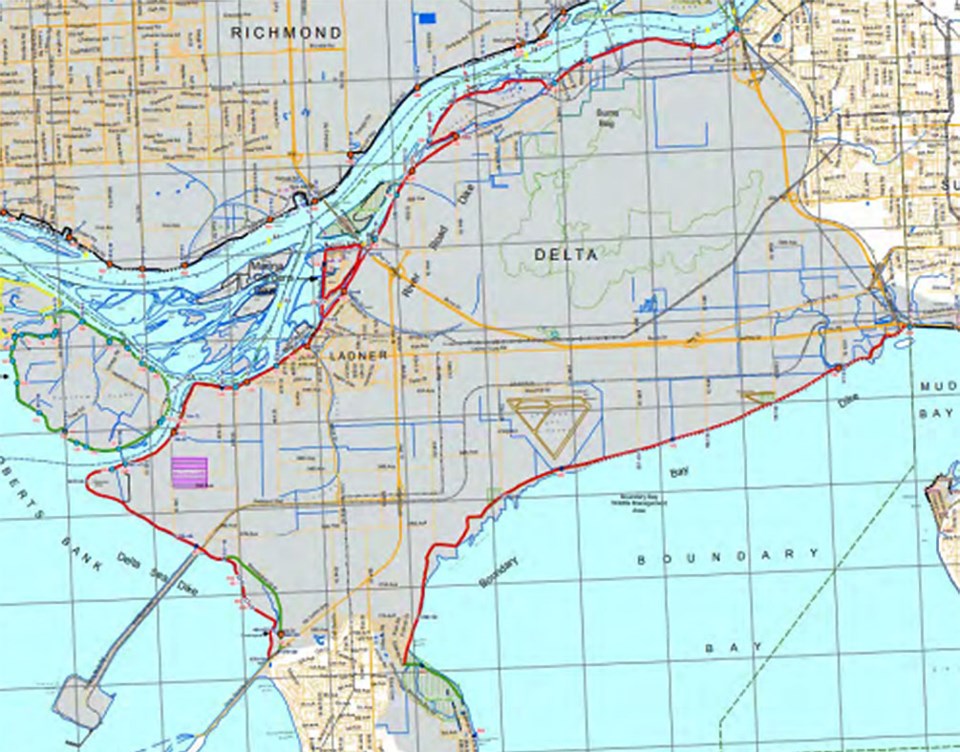It’s going to cost the City of Delta more than $1.9 billion to upgrade its extensive dike system, unless senior levels of government step up and provide financial support.
A recent staff report on Delta’s flood protection and infrastructure initiatives to the Climate Action and Community Livability Advisory Committee outlines some ominous numbers facing the city, which has more than 67 km of dikes that require seismic and other upgrades to meet the latest standards.
Facing the risk of flooding from coastal storm surges as well as the Fraser River spring freshet, the estimated cost, so far, for dike raising and seismic improvements by 2100 is estimated at more than $1.9 billion, with the first phase alone, excluding seismic improvements, tabbed at $350 million.
The city currently has $6.5 billion in private property and public infrastructure protected by Delta’s diking infrastructure, while the estimated damage by a major dike breach is anywhere from $1 billion-to-$3 billion. About 53 per cent of Delta’s land mass is vulnerable to flooding.
The Fraser Basin Council recommends establishing a long-term funding program to support implementation of the Lower Mainland Flood Management Strategy, with senior level government financial support clearly needed.
The report also outlined some of the key upcoming projects for Delta including the Ladner Waterfront Flood Protection Strategy.
That project includes an upgrade for 500 metres of dike along Chisholm Street, as well as raising and upgrading Chisholm Street to increase its elevation.
The city received a $149,500 grant through the Community Emergency Preparedness Fund for planning and design work and has applied for a $20 million grant through the Disaster Mitigation Adaption Fund.
Among the other initiatives is the Living Dike Project, also known as the Boundary Bay Foreshore Enhancement Project, an alternate form of foreshore flood protection.
That project is to develop and test a method of supplying sediment and vegetation on the foreshore to help existing salt marsh habitats increase in elevation and keep up with sea level rise, known as a living dike.
A previous report to council explained the salt marsh can absorb wave energy, reducing the overall wave height that will assist in reducing the dike design elevation and possibly lengthen the timelines for dike raising activities.
The pilot project involves designing and constructing a 250-linear-metre section of raised salt marsh in the foreshore along Boundary Bay near 96th Street.
The report also notes the pilot project is intended through experimental design to develop and inform future designs of larger living dike projects in Boundary Bay.
The city has already signed a memorandum of understanding with the City of Surrey and the Ministry of Forests, Lands, Natural Resource Operations and Rural Development to facilitate construction and permitting of the foreshore enhancement.
Some of the initiatives in Delta's Flood Management Strategy include extensive protection upgrades for the River Road West area, a flood protection strategy for Boundary Bay/Beach Grove, a Beach Grove seawall assessment, the Boundary Bay Construction Fill Pilot Dike Project, Chillukthan Drainage Pump Station upgrades, a new 84th Street Pump Station and the Mason Culvert upgrades.
The latest report notes the next steps include developing a strategy roadmap, engaging residents, committing to a funding model and seeking senior government funding.




